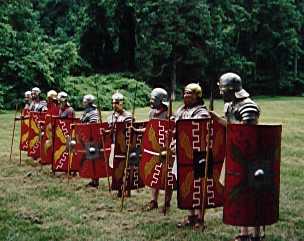

 |
 |
 Roman re-enactors, including a couple of Nova Roman citizens, at Roman Days, June 14, 1998, Glenn Dale, Maryland. |
All clothing and equipment should be as authentic as the modern world allows, tempered with some practicality. Our goal is to recreate Roman soldiers and civilians, not necessarily the individual industries that produced their clothing and accessories. Therefore, fabric does not have to be hand-woven, and armor is made of mild steel, not hand-forged iron.
Bearing that limitation in mind, the best way to make something is the way it was made in Roman times. Dagger scabbards, for example, were made of thin sheet metal, so reproductions should not be cast. Resist the urge to "fake it"— such objects are usually unconvincing, fragile, or both. It is always agonizing to see someone go to great effort to make something wrong!
When planning a project, take time to study these guidelines and any other photos, drawings, and descriptions of original examples that you can find. Don't try to "reinvent the wheel", and stuck to copying excavated artifacts rather than interpreting pictoral evidence, whenever possible.
Burden of Proof: It is up to you to provide historical evidence for any item or technique you wish to use which is not covered in these guidelines; you may not use something just because it cannot be proved wrong! These guidelines are not exhaustive or omniscient, but it should indicate whether some conjecture or extrapolation is necessary. More information can be found in the books shown on the Reading List, so please read! It is also impossible to list the countless ways not to do something; ask for guidance if you have any doubts.
The following rules of thumb should give you some ideas of the goals:
Clothing: Linen or wool, must be 100%, no blends or substitutes. Twills were common. Cotton and silk for civilians only, and must be approved before use. All exposed stitching (hems, etc.) should be done by hand.
Leather: Vegetable-tanned, top grain. Avoid splits, suede, and chrome-tanned leathers. Goatskin and calf were common. May be dyed, and should be treated with wax or oil.
Metal: Mild steel, not galvanized or stainless. Brass may be used for bronze items. No tubular, split, or pop rivets.
Wood: Ash is best for weapon shafts and tool handles. Plywood is used for shields. Exotic types like ebony should be avoided unless provable.
More experienced reenactors can find flaws in virtually everything we wear and use, but understand that perfection is impossible. A reproduction is good enough if a reasonably knowledgeable person can pick it up and try it on without finding any anachronisms. And a good re-enactor will always strive to improve even beyond that point.
![]()